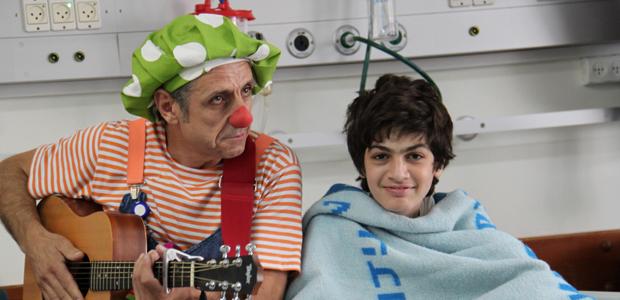The Healing Clowns of Haifa
An Israeli medical clown visits with a young Israeli patient at the children’s hospital. (Photo: Daniel Estrin)
It’s no fun getting blood drawn, especially when you’re four-years-old. Good thing that little Yousef was joined on the examination table by a goofy man with a red nose. The clown grabbed a white medical latex glove, put it to his lips, blew, and ta-dah! It became an impromptu balloon animal – a cow with udders.
Yousef giggled, while the nurse secured a cap onto a small vial of Yousef’s blood. His mom, Manal Zeytoun, said a few months ago her son was diagnosed with a muscle disease. Since then they’ve been regulars at Meyer Children’s Hospital in Haifa.
“The clown help him,” she said. “When the clown come, he is not sick.”
While the clown kept Yousef distracted from the needle in his arm, a few clowns from Holland and Russia peeked their heads in the room. They’re among a group of clowns from Germany, Russia, Holland, Brazil, the US and Canada, who came to Israel in July for some intensive training; they’re studying advanced medical clowning, and Israel is a leader in the field.
In their home countries, the Dutch and Russian clowns entertain patients in the waiting room, but they won’t enter the examining room. Doctors don’t want the distraction, and Anneli Raejs from Holland said that for many years her clown colleagues also didn’t think it was right – they didn’t want to be associated with pain.
“Child say, oh help injection will come because I see a clown. But now we are changing and trying and therefore we are here,” Raejs said.
One clown named “Barambula pistitata kiss kiss hahah,” in overalls and pigtails, is trying to get a grimacing girl named Emily to walk up the stairs. Emily suffered burns on her legs and needs to practice walking again, so Barambula walks with her a step at a time, and jokes with her as she climbs each step.
There are about 70 professional medical clowns in Israel who work in about 20 hospitals throughout the country. The clowns are supported by a non-profit called Dream Doctors. But more and more hospitals are chipping in to pay the clowns. Meyer Children’s hospital, for instance, contributes half of the clowns’ salaries. The hospital keeps at least three clowns on call every day, according to Miriam Goldwaser, the hospital administrator.
“They participate in the treatment as it happens,” Goldwaser said. “Really they are important at the pediatric hospital.”
The University of Haifa’s theatre department offers a bachelors track in medical clowning. Ati Citron, the director of the track, said he believes it’s the first academic program of its kind in the world. He said Israel’s medical clowns are developing new ways to help physicians treat young patients more effectively.
Take Penny Hanuka – a clown who works with rheumatic children who receive regular injections. She is the first to encounter the patient and the family, and she’s the one who gives the cue to the medical team when the patient is relaxed enough to get an injection, Citron said.
“That is a big move on the part of the medical team to say we take our cue from the medical clown. We don’t decide. We want patient to be totally relaxed.” he said.
Another Israeli clown, who calls himself Professor Sancho de la Sponja, created a procedure that persuaded one hospital to stop sedating young patients so they stay still for a diagnostic scan. The clown connects with the child and then they make a deal that they’re both going to freeze during the procedure. Other clowns actually go into pre-op with children and help them relax before surgery.
“Medical clowning is not an entertainment tool,” Citron said. “Yes, it also entertains. But the main objective is to contribute to the healing process of the child.”
And not only children. While I was following clowns around in the children’s hospital, Israeli clown Michael Bash took some of the visiting international clowns next door to the adult dialysis ward. It was the first time they had worked with adults.
“There was one man, lying in bed, sick people, five minutes after that he started dancing in the bed. You can see the change immediately.”
Not every patient wants a clown around. If that’s the case, Bash said he leaves the patient alone.
There’s also reluctance in Israel’s medical community to recognize hospital clowning as a legitimate paramedical profession. Ati Citron said he’s trying to change that.
“We started a full time program because we thought that academization of the profession would eventually make it easy for the Israeli Ministry of Health to recognize it as a creative arts therapy.”
Citron added that if medical clowns were considered bona fide therapists, hospitals would pay them proper salaries, just like doctors and nurses.
That’s still a ways off, but that doesn’t stop Israeli hospitals from keeping Barambula and Penny and Sancho on speed dial.
